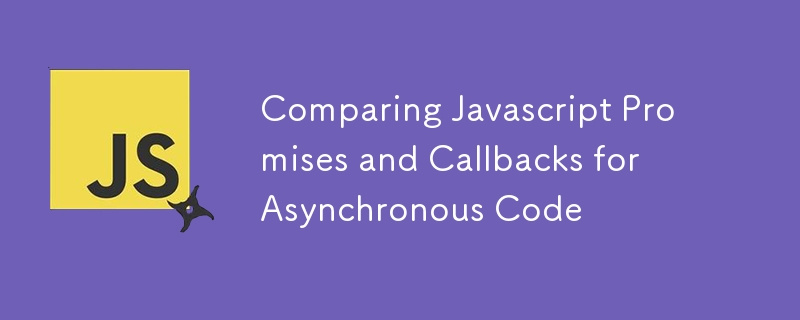Comparing Javascript Promises and Callbacks for Asynchronous Code
Jul 08, 2025 am 02:23 AMBoth Callbacks and promises are used to handle asynchronous operations in JavaScript, but they differ significantly in readability and maintainability. 1. Callbacks are functions passed as parameters, suitable for simple or old environments, but when nested for a long time, it is easy to cause "callback hell". 2. Promise improves code clarity and error handling capabilities through .then() and .catch() chain calls, suitable for complex logic and modern JS features. 3. Use suggestions: Select callbacks for small scripts or old browsers; select Promise when complex asynchronous logic or when using async/await, and convert callbacks to Promise through encapsulation to improve compatibility.

If you're working with asynchronous code in JavaScript, you've probably come across both callbacks and promises. They do similar jobs — letting you handle async operations — but they work very differently. Promises are generally easier to read and manage, especially as your code grows. But to choose the right one for your situation, it's good to understand how each works in practice.

What Are Callbacks and How Do They Work?
A callback is just a function passed as an argument to another function. It gets called later, usually after some async task finishes — like reading a file or making an API request.

Here's a simple example:
function fetchData(callback) {
setTimeout(() => {
callback('Data received');
}, 1000);
}
fetchData((data) => {
console.log(data); // Logs "Data received" after 1 second
});This works fine when you have one or two async steps, but things get messy fast if you have more. You end up with what's often called callback hell — nested callbacks that are hard to follow and debug.

Some pros of callbacks:
- Simple to understand at a basic level
- Supported everywhere (even in old browsers)
But the downsides:
- Harder to scale and maintain
- Error handling can be inconsistent
How Promises Improve on Callbacks
Promises were introduced to make async code cleaner and more predictable. A promise represents a value that may be available now, later, or never. You can chain .then() for success and .catch() for errors.
Here's the same example using a promise:
function fetchData() {
return new Promise((resolve, reject) => {
setTimeout(() => {
resolve('Data received');
}, 1000);
});
}
fetchData()
.then(data => console.log(data))
.catch(error => console.error(error));Promises help avoid deep nesting by allowing chaining:
fetchData() .then(data => process(data)) .then(result => save(result)) .catch(err => handleError(err));
Benefits of promises:
- Better readability with
.then()and.catch() - Easier error handling with centralized
.catch() - Support for multiple async steps without deep nesting
Still, there are cases where callbacks are used — like in older APIs or performance-sensitive situations where overhead matters.
When to Use Each One
Most modern JavaScript uses promises — especially with async/await , which makes them even cleaner. But there are still times when callbacks might be better suited:
Use callbacks when:
- You're dealing with a small script or quick prototype
- The environment doesn't support promises (like very old browsers)
- You're working with a library or API that uses callbacks by design
Use promises when:
- Your app has complex async logic
- You want cleaner error handling
- You're using newer JS features like
async/await
Also keep in mind: many older callback-based functions can be wrapped into promises easily, so you can use them in modern codebases.
A Few Practical Tips
If you're moving from callbacks to promises, here are a few tips:
- Wrap callback-style functions in a promise to integrate smoothly
- Always add a
.catch()at the end of your promise chain to avoid unhandled rejections - Prefer
async/awaitfor long chains — it reads more like synchronous code
One thing people often forget is that promises execute immediately when created. So if you want to delay execution, wrap the promise in a function.
And remember: not all async functions need to return promises. If something is truly synchronous, don't force a promise — it'll just complicate things unnecessarily.
That's the core of the difference between callbacks and promises. Both can work depending on the context, but for most modern applications, promises offer a much smoother experience.
The above is the detailed content of Comparing Javascript Promises and Callbacks for Asynchronous Code. For more information, please follow other related articles on the PHP Chinese website!

Hot AI Tools

Undress AI Tool
Undress images for free

Undresser.AI Undress
AI-powered app for creating realistic nude photos

AI Clothes Remover
Online AI tool for removing clothes from photos.

Clothoff.io
AI clothes remover

Video Face Swap
Swap faces in any video effortlessly with our completely free AI face swap tool!

Hot Article

Hot Tools

Notepad++7.3.1
Easy-to-use and free code editor

SublimeText3 Chinese version
Chinese version, very easy to use

Zend Studio 13.0.1
Powerful PHP integrated development environment

Dreamweaver CS6
Visual web development tools

SublimeText3 Mac version
God-level code editing software (SublimeText3)
 How to make an HTTP request in Node.js?
Jul 13, 2025 am 02:18 AM
How to make an HTTP request in Node.js?
Jul 13, 2025 am 02:18 AM
There are three common ways to initiate HTTP requests in Node.js: use built-in modules, axios, and node-fetch. 1. Use the built-in http/https module without dependencies, which is suitable for basic scenarios, but requires manual processing of data stitching and error monitoring, such as using https.get() to obtain data or send POST requests through .write(); 2.axios is a third-party library based on Promise. It has concise syntax and powerful functions, supports async/await, automatic JSON conversion, interceptor, etc. It is recommended to simplify asynchronous request operations; 3.node-fetch provides a style similar to browser fetch, based on Promise and simple syntax
 JavaScript Data Types: Primitive vs Reference
Jul 13, 2025 am 02:43 AM
JavaScript Data Types: Primitive vs Reference
Jul 13, 2025 am 02:43 AM
JavaScript data types are divided into primitive types and reference types. Primitive types include string, number, boolean, null, undefined, and symbol. The values are immutable and copies are copied when assigning values, so they do not affect each other; reference types such as objects, arrays and functions store memory addresses, and variables pointing to the same object will affect each other. Typeof and instanceof can be used to determine types, but pay attention to the historical issues of typeofnull. Understanding these two types of differences can help write more stable and reliable code.
 JavaScript time object, someone builds an eactexe, faster website on Google Chrome, etc.
Jul 08, 2025 pm 02:27 PM
JavaScript time object, someone builds an eactexe, faster website on Google Chrome, etc.
Jul 08, 2025 pm 02:27 PM
Hello, JavaScript developers! Welcome to this week's JavaScript news! This week we will focus on: Oracle's trademark dispute with Deno, new JavaScript time objects are supported by browsers, Google Chrome updates, and some powerful developer tools. Let's get started! Oracle's trademark dispute with Deno Oracle's attempt to register a "JavaScript" trademark has caused controversy. Ryan Dahl, the creator of Node.js and Deno, has filed a petition to cancel the trademark, and he believes that JavaScript is an open standard and should not be used by Oracle
 What is the cache API and how is it used with Service Workers?
Jul 08, 2025 am 02:43 AM
What is the cache API and how is it used with Service Workers?
Jul 08, 2025 am 02:43 AM
CacheAPI is a tool provided by the browser to cache network requests, which is often used in conjunction with ServiceWorker to improve website performance and offline experience. 1. It allows developers to manually store resources such as scripts, style sheets, pictures, etc.; 2. It can match cache responses according to requests; 3. It supports deleting specific caches or clearing the entire cache; 4. It can implement cache priority or network priority strategies through ServiceWorker listening to fetch events; 5. It is often used for offline support, speed up repeated access speed, preloading key resources and background update content; 6. When using it, you need to pay attention to cache version control, storage restrictions and the difference from HTTP caching mechanism.
 Handling Promises: Chaining, Error Handling, and Promise Combinators in JavaScript
Jul 08, 2025 am 02:40 AM
Handling Promises: Chaining, Error Handling, and Promise Combinators in JavaScript
Jul 08, 2025 am 02:40 AM
Promise is the core mechanism for handling asynchronous operations in JavaScript. Understanding chain calls, error handling and combiners is the key to mastering their applications. 1. The chain call returns a new Promise through .then() to realize asynchronous process concatenation. Each .then() receives the previous result and can return a value or a Promise; 2. Error handling should use .catch() to catch exceptions to avoid silent failures, and can return the default value in catch to continue the process; 3. Combinators such as Promise.all() (successfully successful only after all success), Promise.race() (the first completion is returned) and Promise.allSettled() (waiting for all completions)
 Leveraging Array.prototype Methods for Data Manipulation in JavaScript
Jul 06, 2025 am 02:36 AM
Leveraging Array.prototype Methods for Data Manipulation in JavaScript
Jul 06, 2025 am 02:36 AM
JavaScript array built-in methods such as .map(), .filter() and .reduce() can simplify data processing; 1) .map() is used to convert elements one to one to generate new arrays; 2) .filter() is used to filter elements by condition; 3) .reduce() is used to aggregate data as a single value; misuse should be avoided when used, resulting in side effects or performance problems.
 JS roundup: a deep dive into the JavaScript event loop
Jul 08, 2025 am 02:24 AM
JS roundup: a deep dive into the JavaScript event loop
Jul 08, 2025 am 02:24 AM
JavaScript's event loop manages asynchronous operations by coordinating call stacks, WebAPIs, and task queues. 1. The call stack executes synchronous code, and when encountering asynchronous tasks, it is handed over to WebAPI for processing; 2. After the WebAPI completes the task in the background, it puts the callback into the corresponding queue (macro task or micro task); 3. The event loop checks whether the call stack is empty. If it is empty, the callback is taken out from the queue and pushed into the call stack for execution; 4. Micro tasks (such as Promise.then) take precedence over macro tasks (such as setTimeout); 5. Understanding the event loop helps to avoid blocking the main thread and optimize the code execution order.
 Understanding Event Bubbling and Capturing in JavaScript DOM events
Jul 08, 2025 am 02:36 AM
Understanding Event Bubbling and Capturing in JavaScript DOM events
Jul 08, 2025 am 02:36 AM
Event bubbles propagate from the target element outward to the ancestor node, while event capture propagates from the outer layer inward to the target element. 1. Event bubbles: After clicking the child element, the event triggers the listener of the parent element upwards in turn. For example, after clicking the button, it outputs Childclicked first, and then Parentclicked. 2. Event capture: Set the third parameter to true, so that the listener is executed in the capture stage, such as triggering the capture listener of the parent element before clicking the button. 3. Practical uses include unified management of child element events, interception preprocessing and performance optimization. 4. The DOM event stream is divided into three stages: capture, target and bubble, and the default listener is executed in the bubble stage.






